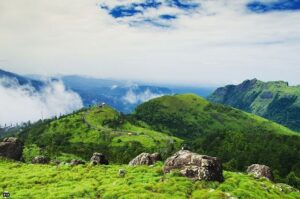The Badami Cave Temples are a complex of Hindu and Jain cave temples located in Badami, a town in the Bagalkot district in northern part of Karnataka, India. Badami Cave Temple is truly famous for its Cave Temples that date back to the 6th and 7th centuries. Cave Temples represent the fine architectural style of the ancient times. Badami is sited at the orifice of a gorge that is fringed by two rocky hills.
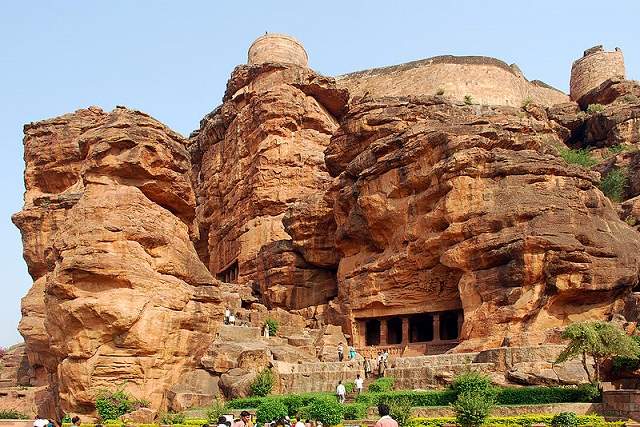
Page Contents
Architecture:
Badami is acknowledged for being the ancient kingdom of Chalukyas. In the 6th century, Badami was established by Pulakesin I; however the architectural expansion was observed by the Chalukyas. The sect constructed numerous temples and monuments, marking the instigation of the Hindu architectural style. Badami Cave Temple is the best example of Chalukyan style of architecture. Made out of Sandstone hills, Badami Cave Temples boast of rock-cut architecture.
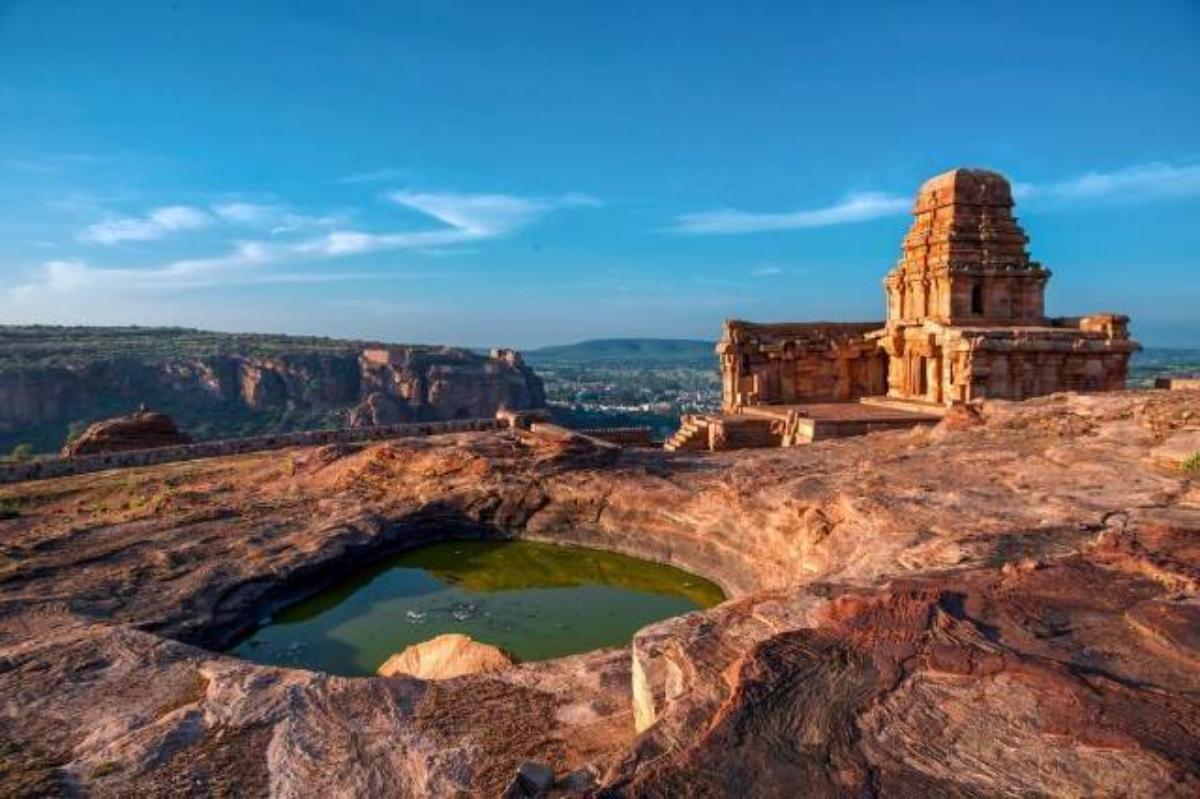
In totality, there are four cave temples in Badami. All these temples enclose brilliant carvings with the sculptures of Gods from the Hindu pantheon. The structure of these temples is a perfect fusion of North Indian Nagara style and South Indian Dravidian style of architecture. Each cave embraces a sanctum, a hall, a verandah and pillars. Beautiful carvings and exquisite sculptures adore the site of Cave Temples. At the cutting edge, one can see a reservoir that makes a perfect foreground to these architectural structures.
Caves Temples:
The four most important and spectacular caves at Badami are Caves 1 to 4, and these are situated in a soft sandstone escarpment in the hill at Badami. The sandstone is very fine quality banded yellow to red sandstone, with very fine banding, and is very amenable to carving and polishing. This has resulted in a high degree of detail and an exquisite finish. Caves 1 to 3 are Brahmanical Caves and Cave 4 is a Jain Cave. The caves were sculpted between the 6th and 8th centuries CE.
Cave 1:
Cave 1 has an imposing entrance that is cut 18 metres above the surface and has a steep flight of stairs leading up to it. The verandah of the cave has two wings cut into the rock, and on the right (as you face the cave from the outside) is a fantastic, 18-armed image of Shiva dancing the tandava with his son Ganesh to his left and Nandi behind him. He is accompanied by a seated drummer.
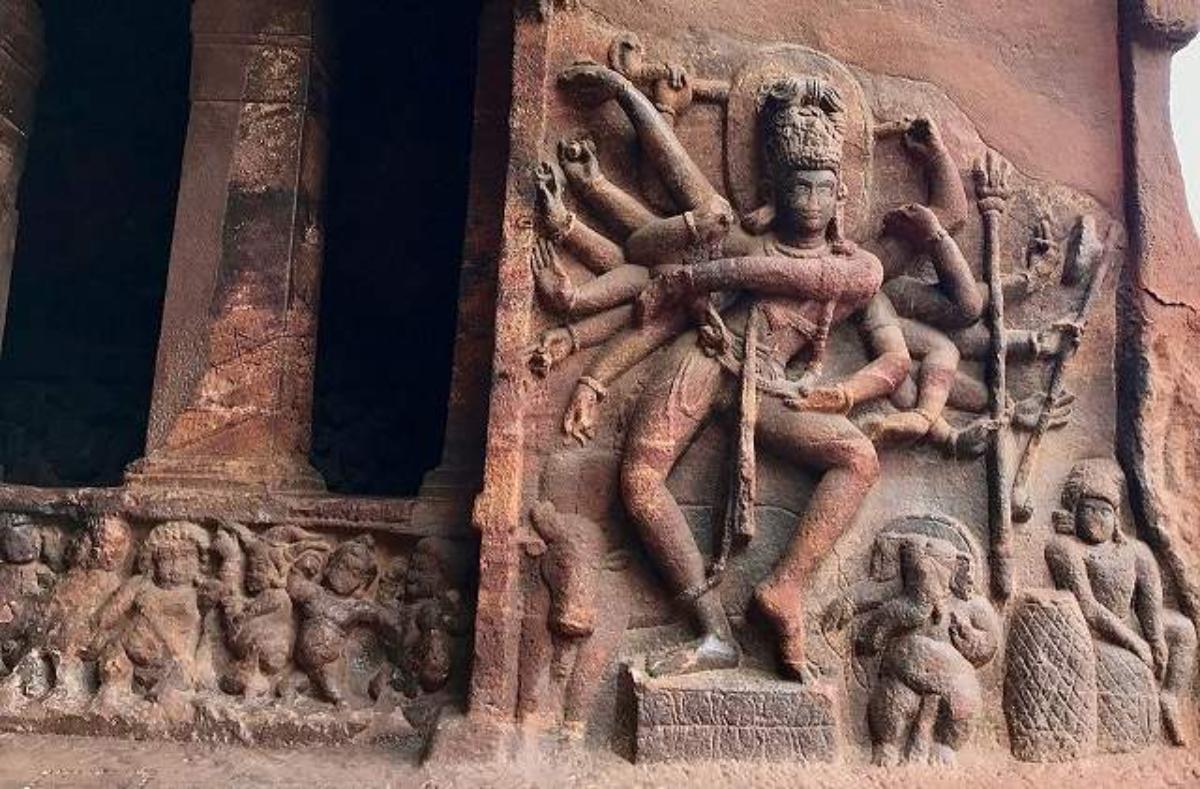
Nataraj In Cave 1
The wing on the cave’s right is short and has a trident-bearing Shaivite dwarapala (doorkeeper) portrayed there. The entire verandah sits on a plinth with ganas frolicking below. Two square-sectioned columns flank each side of the entrance. Inside the cave are some very interesting images. One of the most prominent ones is that of Harihara (half Vishnu and half Shiva) flanked by their respective spouses, Laxmi and Parvati. There are also images of Ganesh and Kartikeya, the sons of Shiva & Mahishamardhini, as well as other deities. The inner pillars are square-sectioned with cushion capitals and are reminiscent of the caves at Dharashiv and Elephanta.
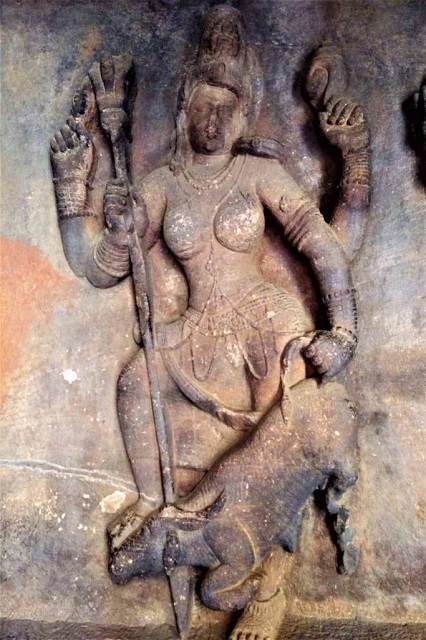
Sculpture of Goddess Durga killing the buffalo demon Mahishasura in Cave 1
Cave 2:
Cave 2 is above and to the east of Cave 1 and faces north. It was created in late 6th or early 7th century. It is smaller than Cave 1, somewhat similar in terms of its floor plan, but it is dedicated primarily to Vishnu. Cave 2 is reached by climbing 64 steps from the first cave. The cave entrance is a verandah divided by four square pillars with ends as half pillars, all carved out of the monolithic stone face. The pillars have decorative carvings with frieze of ganas (mythical dwarfs) with various facial expressions. On the two sides of the entrance are standing dvarapalas (guardians) holding flowers, not weapons. Like Cave 1, Cave 2 art reflects Hindu theology and arts.
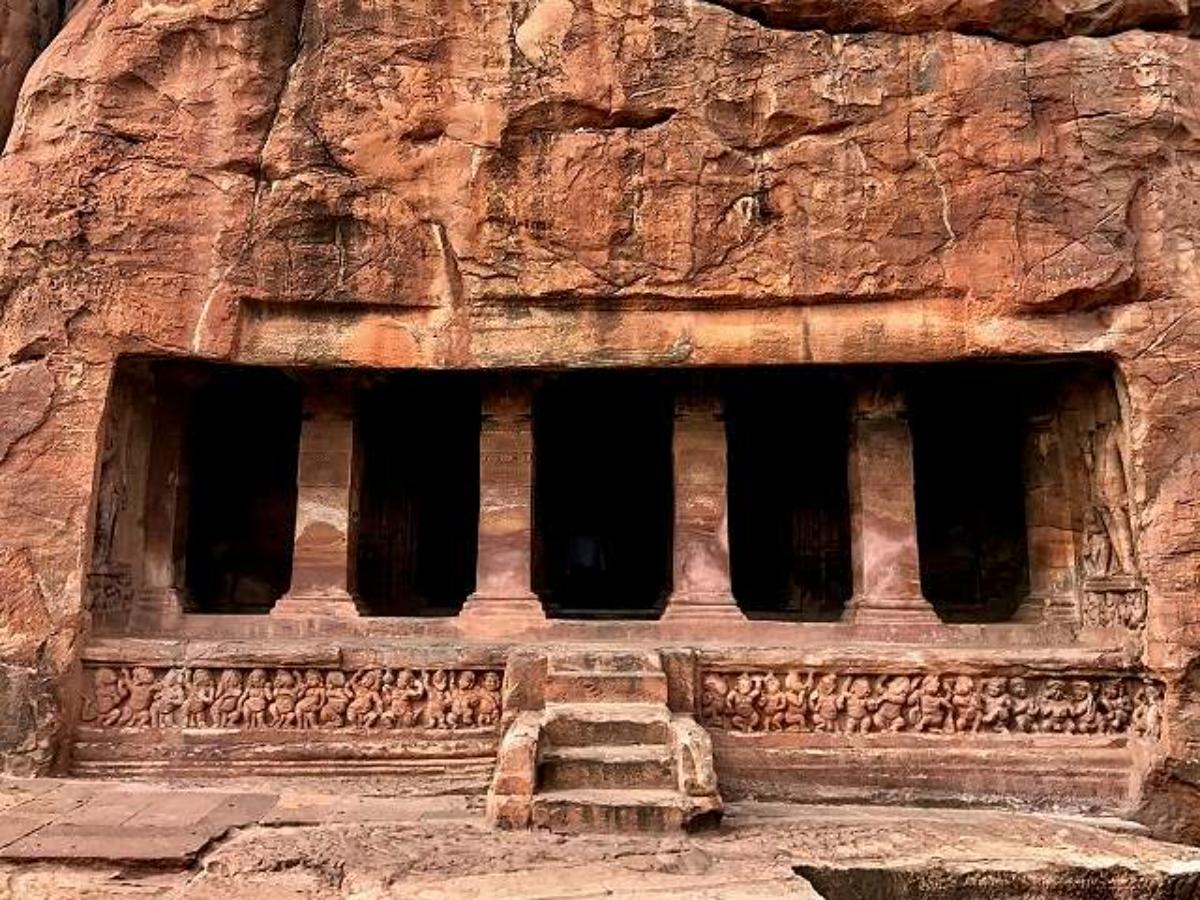
The entrance of Cave 2
The largest relief in Cave 2 depicts the legend of Vishnu in his Trivikrama form, taking one of the three steps. Below the raised step is a frieze showing the legend of Vamana dwarf avatar of Vishnu, before he morphs into the Trivikrama form. Another major relief shows the legend of Vishnu in his Varaha (a boar) avatar rescuing goddess earth (Bhudevi) from the depths of cosmic ocean, with a penitent multi-headed snake (Nāga) below. Like other major murti (statue) in this and other Badami caves, the Varaha artwork is set in a circle and symmetrically laid out; according to Alice Boner, the panel is an upright rectangle whose “height is equal to the octopartite directing circle and sides are aligned to essential geometric ratios, in this case to the second vertical chord of the circle”. The walls and ceiling have traces of colored paint, suggesting the cave used to have fresco paintings.
Inside the temple are friezes showing stories from Hindu texts such as the Bhagavata Purana. These show the legend of cosmic ocean churning (Samudra Manthan) and Krishna’s birth and flute playing indicating the theological and cultural significance of these in 7th century India. The ceiling and door head carvings show Gajalakshmi, the swastika symbols, flying couples, Brahma, Vishnu asleep on Shesha and others.
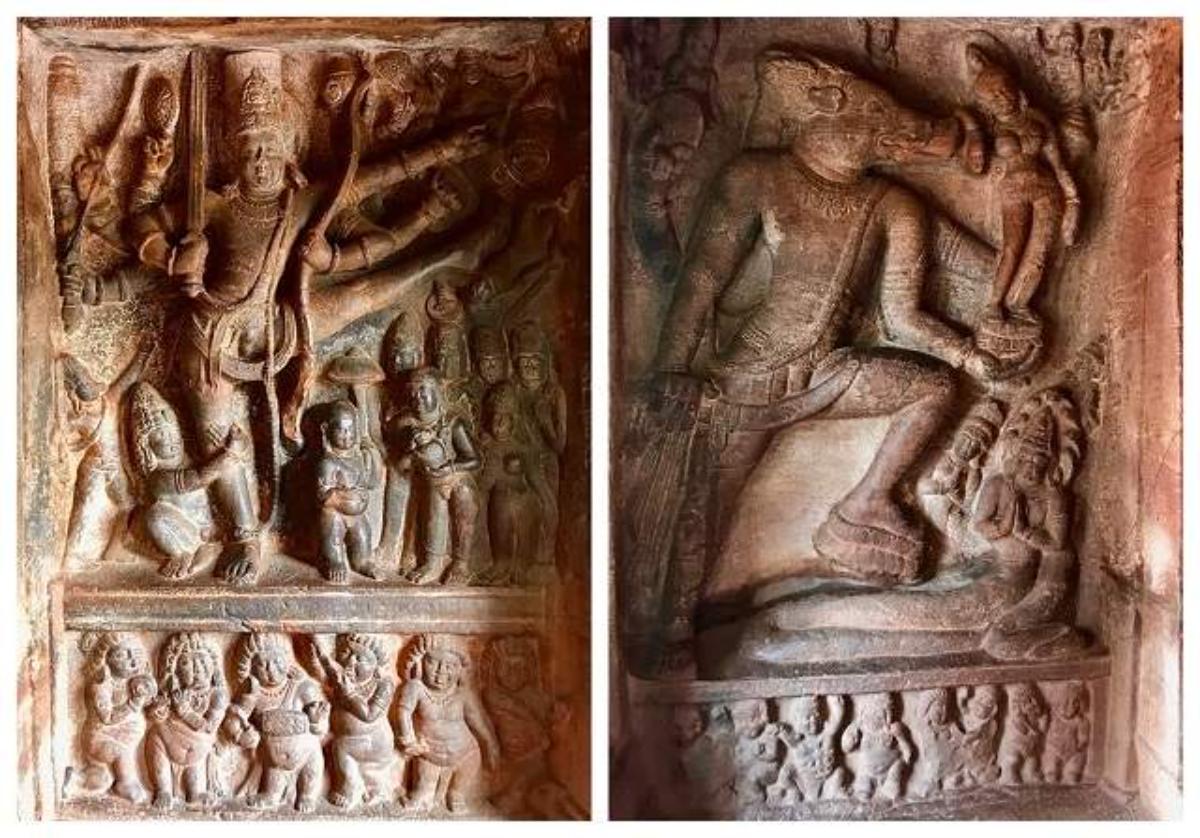
Vishnu as Vamana and Varaha in Cave 2
The ceiling of Cave 2 shows a wheel with sixteen fish spokes in a square frame. The end bays have a flying couple and Vishnu on Garuda. The main hall in the cave is 33.33 feet (10.16 m) wide, 23.583 feet (7.188 m) deep, and 11.33 feet (3.45 m) high and is supported by eight square pillars in two rows. The roof of this hall has panels filled with bas-relief carvings. The sculptures of Cave 2, like Cave 1, are of the northern Deccan style of the 6th and 7th century similar to that found in Ellora Caves.
Cave 3:
Cave 3 is probably the oldest and was built between 575 and 585 CE. It bears an inscription of Mangalesha, the third ruler of the Chalukyan dynasty. The inscription is dated 578 CE. It is a simple, rectangular cave with a courtyard, which is reached after climbing a broad flight of 60 stairs. The cave ‘sits’ on a raised pedestal, which has pairs of ganas carved into it. These ganas are reminiscent of the ganas seen at the Vakataka temples at Ramtek near Nagpur in Maharashtra. The outer column of pillars has a simple square section with elaborate capitals. It has a narrow verandah (7 feet wide) and a main pillared hall with a recessed sanctum. The pillars within are fluted with cushion capitals.
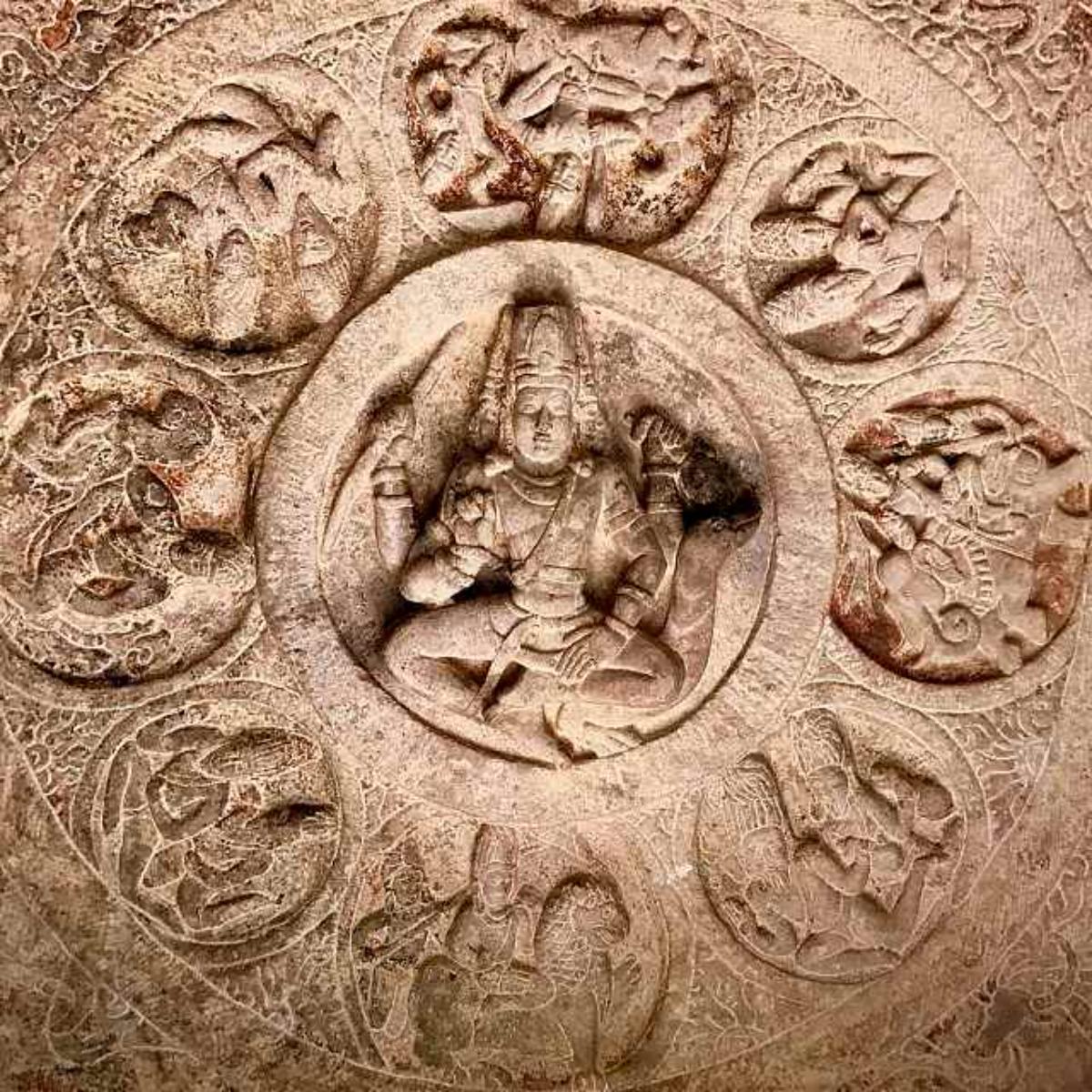
Brahma on Hamsa in Cave 3 ceiling
The cave is dedicated, in all probability, to Vishnu as most of the shrines within it are Vaishnavite. There are images of the Trivikrama, Varaha and Narasimha avatars of Vishnu; a half Vishnu, half Shiva Harihara image; there is also an image of the wedding of Shiva and Parvati and the central mandapa (porch or assembly hall) has eight images of gods carved into the ceiling. One of the most impressive images here is that of a four-armed Vishnu seated on Sheshanaga. This is a very rare depiction.
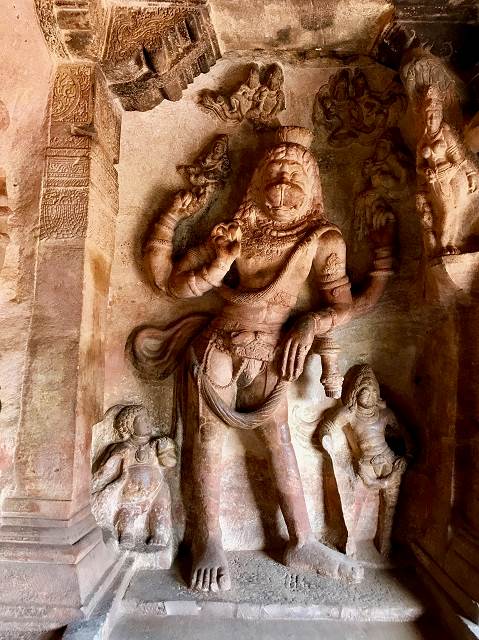
Sculpture of Lord Vishnu in the avatar of Narasimha (half human and half lion) at Cave 3
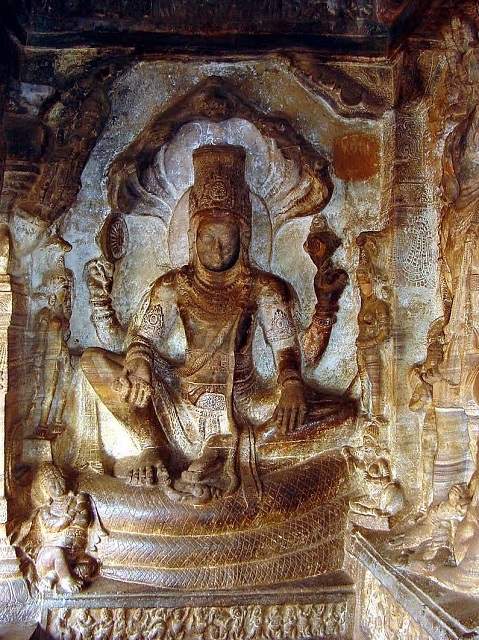
Seated Vishnu on Sheshanaga, the most famous Badami sculpture
There are a few traces of fresco paintings telling us that, at one time, the sculptures, walls, ceilings and pillars were all covered in painted plaster. This is some of the earliest evidence of Brahmanical cave frescos in India. The paint in the ceiling panels of the verandah is still very fresh and a number of deities are seen within them. Many of the pillars depict erotic couples. The cave is exquisitely carved with painstakingly detailed sculptures.
Cave 4:
Located immediately next to and east of Cave floor is situated about 10 feet lower and is the smallest of the four. It is dedicated to Tirthankaras, the revered figures of Jainism. It was constructed after the first three, sponsored by Hindu kings in later part of the 7th-century. Some scholars state this cave may have been created in the 8th Some embellishments were likely added in later centuries until about the 11th or 12th century.
Like the other caves, Cave 4 features detailed carvings and a diverse range of motifs. The cave has a five-bayed entrance with four square columns – each with brackets and capitals. To the back of this verandah is a hall with two standalone and two joined pillars. The first aisle is a verandah 31 feet (9.4 m) long by 6.5 feet (2.0 m) wide, extending to 16 feet (4.9 m) deep. From the hall, steps lead to the sanctum sanctorum, which is 25.5 feet (7.8 m) wide extends to a depth of 6 feet (1.8 m).
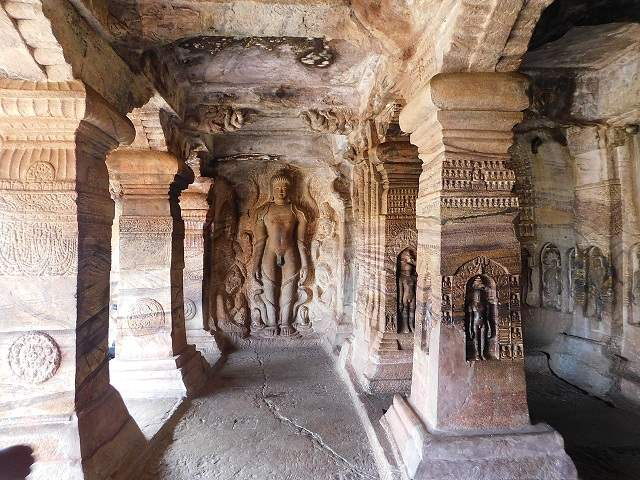
Cave 4 with a sculpture of Bahubali
Inside the cave are major carvings of Bahubali, Parshvanatha and Mahavira with symbolic display of other Tirthankaras. Bahubali is standing in Kayotsarga meditating posture with vines wrapped around his leg, his classic iconography. Parshvanatha is shown with the five-headed cobra hood. Mahavira is represented sitting on a lion throne, whose identifying markers are not visibly and is identified by some scholars simply as a “seated Jina”. This figure is flanked by bas-reliefs of attendants with chauri (fans), sardulas and makara’s heads. Other carvings include Indrabhuti Gautama covered by four snakes, Brahmi and Sundari. In the sanctum is an image of Mahavira resting on a pedestal containing a 12th-century Kannada inscription marking the death of one Jakkave. Twenty-four small Jaina Tirthankara images are engraved on the inner pillars and walls. In addition there are idols of Yakshas, Yakshis and Padmavati.
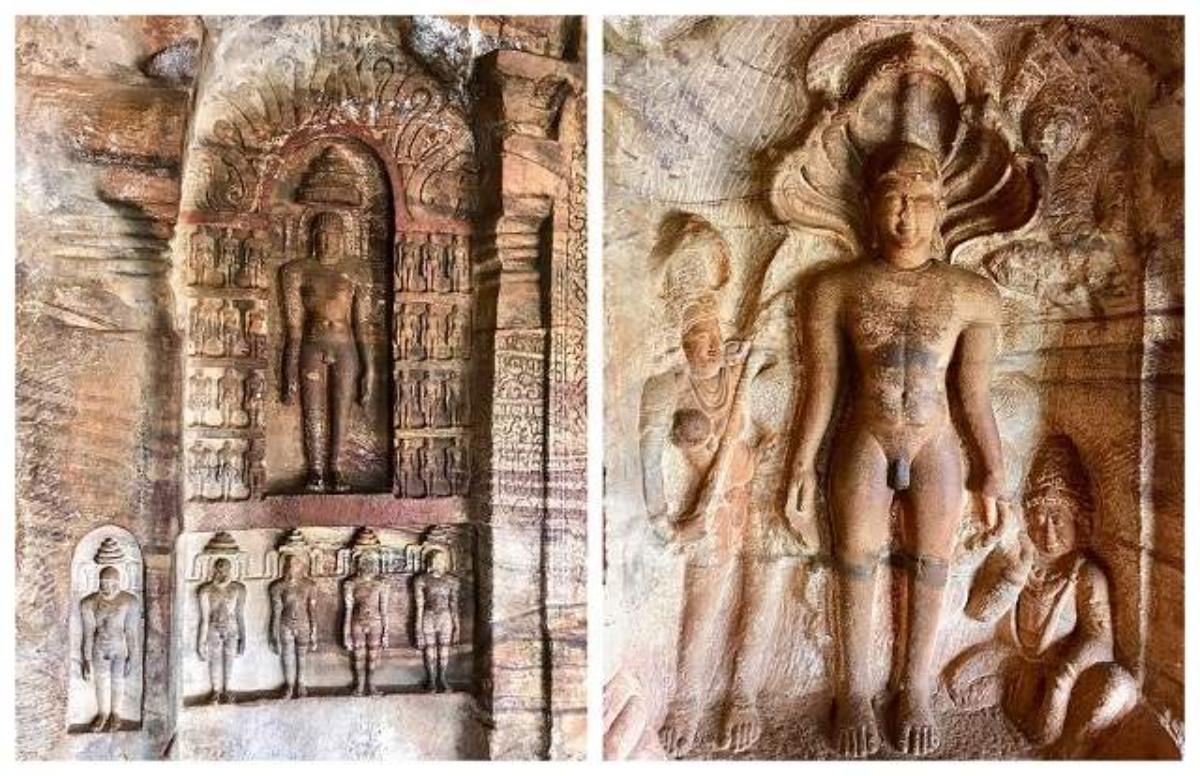
Mahavira and Parshvanatha in Cave 4
The artistic work, the icons to represents ideas and the motifs in Badami Cave 4, states Lisa Owens, resembles those of nearby Aihole Jain caves and much farther north Ellora Caves Jain caves in northern Maharashtra.
Timings:
09:00 am – 05:30 pm
Best time to Visit:
The winter months from October to March is the best times to visit Badami.
How To Reach:
By Train:
Badami has a railway station which is 5 km away from the town center. Tourists can also catch the trains from Hubli or Solapur.
By Road:
Badami is 450 km away from Bangalore, via NH48 and NH50. Regular buses are plying between Badami and major cities like Hospet, Bangalore, Gadag, and Bijapur.
By Air:
The closest airport to Badami is Hubli Airport, which is 84 km away. Another airport is Sambre Airport in Belgaum which is 123 km away.


